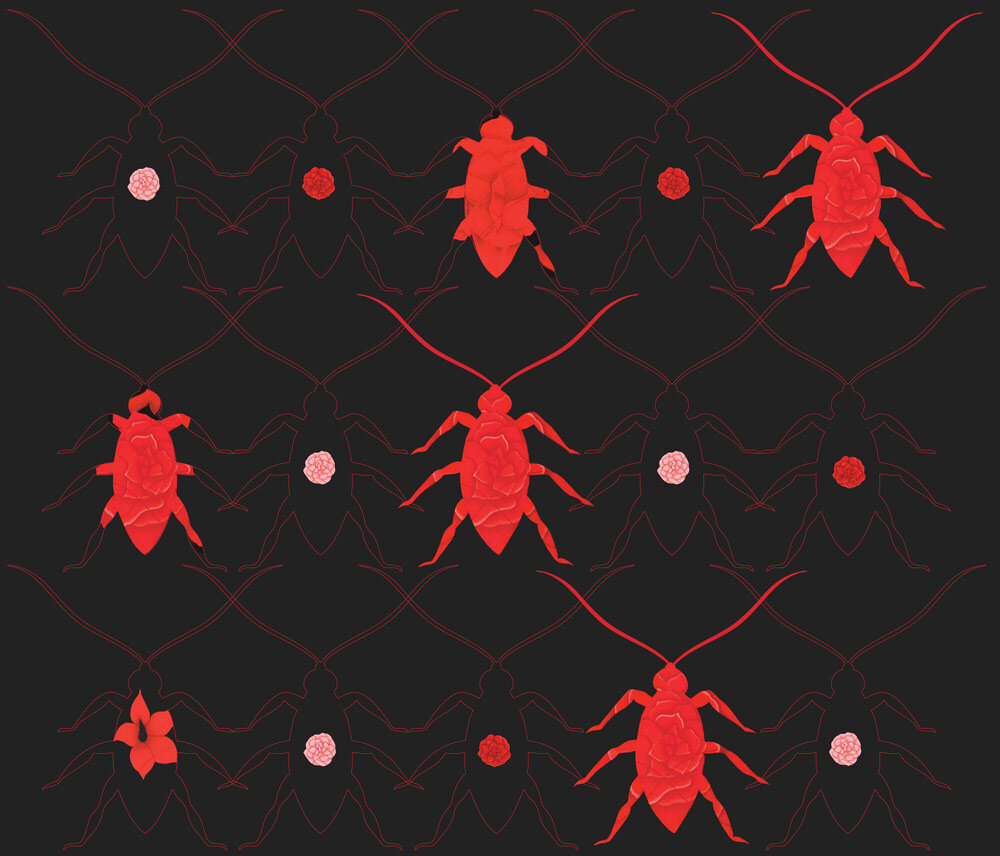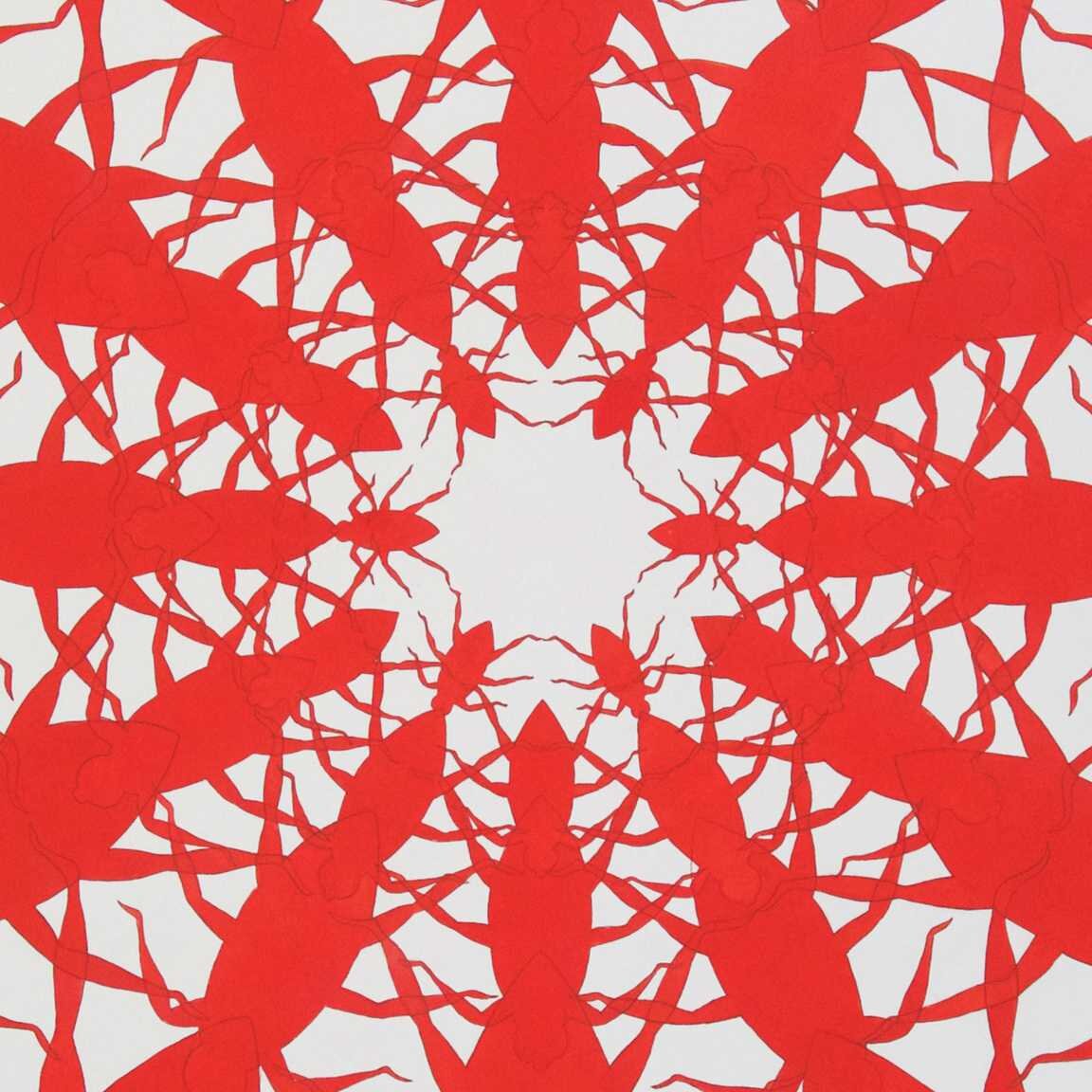Tazeen Qayyum
Assembly Line
In this edition of #SAIatHome, artist Tazeen Qayyum talks to us about her featured work ‘Assembly Line,’ from our current exhibition Old Traditions, New Narratives: South Asian Miniatures. This work offers both a critical look at mindless followers and a perspective immigrants as resilient.
Tazeen Qayyum is a graduate of National College of Arts in Lahore, Pakistan, and currently resides in Toronto, Canada. As an immigrant herself, she often reacts to political and social injustices in her work, which are typical to the Neo-miniaturist commentary on political, religious and cultural taboos. The finished works are not usually overt statements, but are done with a lot of symbolism and satire. These subversive messages may not be readily apparent to the outsider who is unaware of the context or the traditional imagery.
In 2002, Qayyum began using the cockroach motif to represent issues of war, racism, and discrimination against cultures that are considered “outsiders.” A hardy and adaptable creature, the cockroach is known to elicit fear because it is perceived to be harmful and dangerous. Alternatively in Qayyum’s work, it becomes a predominant symbol of resilience.
When and how did you first decide to use the cockroach as a symbol in your work?How would you describe what you want the narrative of this creature to be?
The image of the cockroach crept in my work (pun intended) back in 2002 when the US and its allies launched the war on terror.
Generally branded for repulsion with some redeeming qualities of resilience and survival, a cockroach motif for me, serves as a social commentary on how in today’s war and hate-driven environment, the value of human life is reduced to that of a pest insect; yet it also narrates the everyday human stories of resilience and triumphs over adversities. Over many years the cockroach motif and its narrative have evolved in my work and the idea of fear and its manifestation has remained central.
When I started using this motif, it was to depict the countless death and destruction caused by war and terror attacks, therefore the earliest works represented a dead roach painted in multiple numbers. Evolving the work further, I started mimicking entomology museum displays, referencing archival practices to show how they parallel political propaganda and their role in documenting histories. I felt I could address multiple concerns through the same motif, and the work further evolved where multiple narratives were achieved by simplifying the imagery. Over the years we were also seeing a constant and complex shift in the global political landscape. The idea of fear and the mechanisms of power became central to my work.
The wonderful thing about staying constantly in practice for an artist is that one always keeps growing, learning, and experimenting. I wanted to express my ideas in different mediums, which led to bringing the cockroach from the painted surface to the 3-dimensional, which lead to large installations and sculptural works. Depicting a systematic march, growth, and multiplicity through pattern making, repetition, rhythm, balance, and geometry became methodological devices to create visually complex works that offer a multi-layered understanding of my concerns and techniques used.
“…the value of human life is reduced to that of a pest insect; yet it also narrates the everyday human stories of resilience and triumphs over adversities.”
Do you believe that your cockroach motif can be used as exposure therapy to confront the viewer and expose them just enough to overcome the uncomfortable feeling with the creature? How does this relate to immigrants overall and ideas of visibility?
I take pleasure in combining beauty with the grotesque and discomfort with humor.
Selecting a cockroach motif in particular as my metaphor references the notion of 'stereotyping the unknown.’ Ornately painting a household pest that is universally detested and difficult to eradicate, shows an interesting contrast of beauty and repulsion, acceptance and discomfort, drawing a parallel with people and cultures different from our own, and our immediacy to label them undesirable. In today's growing atmosphere of religious and political intolerance, the fear of the 'other' is no longer a mute condition but has translated into a cacophony of acts of bigotry and brutality under the disguise of misrepresented and misquoted socio-political and religious ideologies. Furthermore, the voice of reason and freedom of speech has increasingly become difficult to attain and perform. My work acts as a reminder to myself and the audience, that the responsibility to question, challenge, and of facing the truth lies within all of us.
‘Assembly Line.’ created in 2009, mimics a manufacturing plant where colored pipes systematically form a network, eventually converging to produce identical cockroaches as if on a conveyor belt. The work offers a critical look at the multiplicity of mindless followers created through extremist ideologies, may it be religious or political. For years extremist ideologies around the world have gone unchecked which I believe, has caused the widening of the divide that we see around us and the voice of reason and tolerance being lost. This painting also references the plight of the migrant and poor, many such laborious and menial jobs are held by immigrants, undervalued yet resilient, and able to survive in the most hostile circumstances.
In this regard, the socially rejected household pest cockroach in its subtle macabre humor engages the audience to ponder the meaning of inclusion, tolerance, hope, and resilience.
“stereotyping
the
unknown”
How has your personal immigrant experience shaped your art works and the message you are trying to convey?
Looking back at my practice, it has always been important for me to look at our environment critically and realize our role in it. At the same time, like most other artists, art is a journey of self-discovery, and for that to be authentic it is very important that one remains honest with their work.
Inspiration comes in many forms, oftentimes it is the personal stories and struggles that move me. I believe that the immigrant narrative has long been an influence on who I am, how I engage with circumstances, people, and my work, and not just because of my personal immigration to Canada some 17 years ago, but from much before. My grandparents and extended family immigrated from India to Pakistan during Partition. I grew up surrounded by their fascinating, almost fairytale-like stories, drawing images in imagination of what their lives and homes were like, all while growing up and navigating the political landscape of Karachi, a city of the migrants. It all had an impact on who I am, it taught me that as individuals and a collective society, we need to be aware, knowledgeable, compassionate, and understand the alternate voices and narratives around us. Now living in the diaspora my work often draws on complex issues of belonging and displacement within a socio-political and religious context, my art has become a way for me to navigate my identity and beliefs.
As a performance artist as well, would you like to share a video of one of your performances and comment on it?
I like to challenge myself and continually explore new materials and processes through mediums such as drawing, painting, installation, sculpture, video, and performance.
By combining my drawing and performance practices, I explore how these two modes construct, evolve, and poetically inform each other. Performing live, the body itself becomes a medium, like a brush or a pen and the focus is not on the final outcome, instead, the drawing process becomes the shared activity, an immersive experience connecting me, the drawing, the sound, and the viewer for the duration of the performance.
Repeatedly drawing a single word or phrase for hours at a time creates a detailed concentric abstract form resembling the organic attributes of a spiral, an eye, a mandala, or a black hole. Each drawn word is carefully selected, expanding my socio-political field of inquiry and a means to focus inwards and connect with myself.
The most recent performance I did was in Vienna last month as part of the Salam Orient music festival. I collaborated with Marwan Abado, an established musician of Palestinian heritage. During the performance, we were both responding to each other spontaneously and to the emotion of a selected word, Ehsaas احساس, that I kept drawing. We chose the word Ehsaas because it represents an emotion, a feeling to be aware of others, to care. Drawing from empathy, this poetic word offers a quiet reflection for all in these significant times of COVID-19. If anything, these times have made us realize what is most important in life, who is important, and the realization of how little is in our control.









